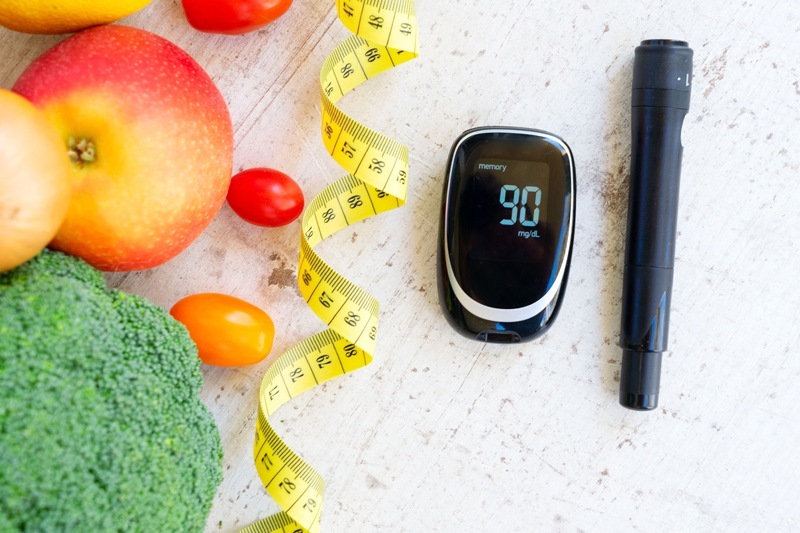When you consume food, that food is broken down into glucose and it enters your bloodstream.
From there, usually, when the blood sugar is high, your body will signal to your pancreas to release insulin to lower the blood sugar count. In people with diabetes, the pancreas either doesn’t produce enough insulin or doesn’t properly use it to fight off high blood sugar.
“Basically, diabetes is a disorder where our bodies don’t store and use sugar appropriately,” said Jennifer Trujillo, one of the physician assistants and founders of Valencia Health and Wellness in Belen. “And most of the time because it’s bombarded with too much of it. So typically, what I tell a patient is when they’re diabetic, it means they have too much excess sugar.”
According to the Center for Disease Control and Prevention, more than 34 million Americans in the United States suffer from the medical condition, and around one in five people don’t know they have it.
Trujillo and Cassandra Otero, the other physician assistant and co-owner of VHW, said about a quarter of the patients they treat are diabetic and even more are prediabetic.
About 88 million Americans have prediabetes, which means their blood sugar is higher than normal but not high enough for a diabetes diagnosis. That is one in three Americans who can get diabetes, and around 84 percent don’t even know they are on that path.
Prediabetes, according to the CDC, puts you at a higher risk for Type 2 diabetes, a stroke or a heart condition.
Some signs and symptoms of prediabetes can be obesity, being over the age of 45, having an immediate family member with diabetes, being inactive physically, among other issues.
However, prediabetes doesn’t mean you will inevitably get it. It can be prevented, in fact, by leading a healthier lifestyle.
“You know, keeping to a really low carbohydrates and sugar diet makes a big difference and cutting out sugary drinks,” Otero said. “Anything white is usually what I tell my patients to stay away from: pasta, potatoes, rice and, of course, any sugars.”
Types of diabetes
There are two main types of diabetes — Type 1 and Type 2.
Type 1 diabetes isn’t due to lifestyle habits such as overeating and no exercise. A lot of people who have Type 1 diabetes are either born with the disease or has an autoimmune reaction that causes the body to turn against itself, using cells to destroy the pancreas.
When that pancreas is destroyed, it either creates no insulin at all or hardly any, which leaves a large dependency on being treated with insulin on a daily basis. That means either taking multiple insulin shots a day or wearing an insulin pump to make sure the blood sugar level is maintained.
Most people who are diagnosed with Type 1 diabetes are usually younger, such as children, teens and young adults. Only 5-10 percent of diabetics have Type 1, according to the CDC.
As for Type 2 diabetes, which is the most common type amongst Americans, it is most common in people older than 45 but is becoming more common in those younger. Type 2 diabetes is caused by lifestyle and diet not being maintained correctly, such as overeating and no exercise.
“Type 2 diabetics, we typically start with lifestyle modification — so we have them increase their exercise and change their eating habits,” Trujillo said. “And then, from that point on, if it’s difficult to control, then we start them on oral medications. As their disease progresses, often they’ll need insulin.”

Julia M. Dendinger | News-Bulletin photo
Jennifer Trujillo and Cassandra Otero, both physician assistants at Valencia Health and Wellness, treat people with diabetes, Type 1 and Type 2, as well as those who are prediabetic.
Trujillo and Otero said there is a new form of diabetes — Type 1 1/2 as they call it, though not official — which is an early onset type of diabetes before being diagnosed with Type 1 or Type 2. It is most common in children, they said, and the issues largely surround sugar levels.
There is a type of diabetes known as gestational, which is diagnosed in pregnant women who don’t already have the disease. Around 2-10 percent of pregnancies are affected yearly by this type of diabetes, according to the CDC.
If a properly-maintained diet and lifestyle happens during pregnancy, gestational diabetes can likely go away. If that isn’t the case, though, this type can turn into Type 2 diabetes.
“During pregnancy, your body makes more hormones and goes through other changes, such as weight gain,” the CDC says of gestational diabetes. “These changes cause your body’s cells to use insulin less effectively, a condition called insulin resistance. Insulin resistance increases your body’s need for insulin.”
Effects of diabetes
Diabetes, like many health conditions, can inevitably lead to death if poorly maintained. However, for those that don’t properly take care of it, heart attacks, numbness in limbs and vision problems can arise.
“It affects the heart, the kidneys. It also affects the nerves. So a lot of people have numbness, tingling and can’t feel their feet in particular,” Otero said. “Vision is another issue. It affects the very small vessels in the eye and causes problems there, such as a loss of vision.
“It can create the need for dialysis and kidney failure,” she said. “But cardiovascular disease and heart attacks are probably the most common issues.”
Trujillo and Otero say a healthier lifestyle — more exercise and better diets — are the best way to maintain or prevent diabetes, but for those living in Valencia County it can be much harder. The reasoning, they said, is because the county is known as a food desert — with less access to healthier, organic foods.
“We see a lot of amazing improvements in patients that really get serious,” Trujillo said. “But that’s the hardest part of treatment of all, is making those changes.”
How to manage diabetes
While medicine is an important factor in maintaining diabetes, the most important factor is eating healthy. High blood sugar and low blood sugar can adversely affect a diabetic, so maintaining a healthy balance of carbs is essential.
Carbs can come in three forms — sugar, starches and fiber. According to the CDC, diabetics should try for at least half of their day’s calorie count to be that of carbs, albeit healthy ones like fresh fruit and rolled oats.
Insulin, which helps the body process those sugars, is another key factor in maintaining diabetes. If your blood sugar count is too high, a shot of insulin can bring it down to normal levels. However, that’s not always the case — and the best way to maintain medication is to keep your doctor properly informed of blood sugar levels.
Exercise is another way to maintain diabetes. When you workout, your body uses sugar for energy. This is a great way to shy away from too high of blood sugar levels. Exercise for diabetics can be as simple as taking a daily walk, or lifting light weights for half an hour. Basically, keeping your body moving.
“Exercise. The more muscle mass you have, the more you can utilize that extra sugar floating around in the bloodstream,” Otero said.

















